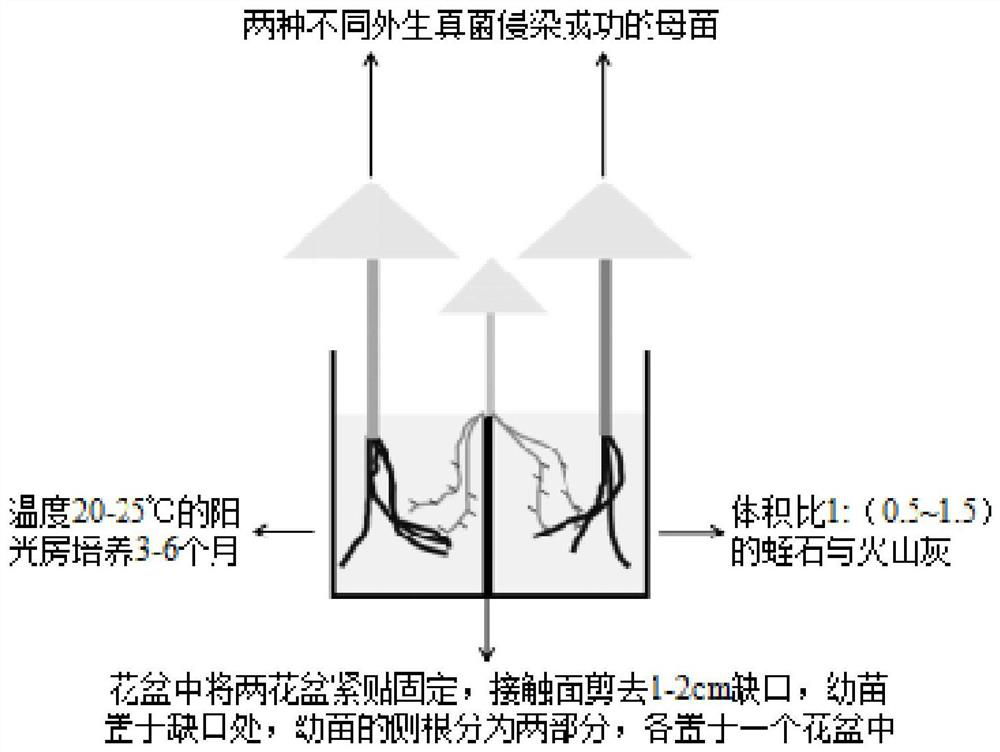A kind of mycorrhizal multi-inoculation method and application of woody plants
A woody plant and mycorrhizal technology, applied in the field of multi-inoculation of woody plant mycorrhiza, can solve the problem of microbial community restoration, soil improvement and fertility restoration. It cannot better promote plant colonization, and the effect is not as good as multi-inoculation Plants and other problems, to achieve the effect of promoting the diversity of microbial communities, rapid mycorrhizal rate of infection, and not easy to interfere with bacteria
- Summary
- Abstract
- Description
- Claims
- Application Information
AI Technical Summary
Problems solved by technology
Method used
Image
Examples
Embodiment 1
[0054] Example 1 Pisolithus tinctorius and Cenococcum geophilum inoculation
[0055] S1 Cultivation of plant seedlings to be inoculated: After soaking in 75% alcohol for 30 seconds, soaking in 10% sodium hypochlorite for 10 minutes, and then washing the seeds with sterilized water for 3 times, put the sterilized black pine seeds in a 25°C incubator to accelerate germination. When the seeds start to show white, they are sown into the culture substrate sterilized at 121° C. for 2 hours. The substrate used is vermiculite, and the cultivation environment is a sun room with a temperature of 20-25° C.
[0056] S2: After the seeds described in S1 are cultivated until they grow into seedlings, cut off the root tip of the tap root and keep the 1.5 cm tap root.
[0057] S3: Fix the two plastic flowerpots close to each other, and cut a gap of 1cm in depth on the two adjacent surfaces.
[0058] S4: The seedlings of S2 are placed in the gap, and the lateral roots of the seedlings are ...
Embodiment 2
[0065] Example 2 Laccaria bicolor and Laccaria amethystina inoculation
[0066] S1 Cultivation of plant seedlings to be inoculated: After soaking in 75% alcohol for 30 seconds, soaking in 10% sodium hypochlorite for 10 minutes, and then washing the seeds with sterilized water for 5 times, put the sterilized black pine seeds in a 25°C incubator to accelerate germination. When the seeds start to show white, they are sown into the culture substrate sterilized at 121° C. for 2 hours. The substrate used is vermiculite, and the cultivation environment is a sun room with a temperature of 20-25° C.
[0067] S2: After the seeds described in S1 are cultivated until they grow into seedlings, the root tip of the tap root is cut off, and the 2.5 cm tap root is retained.
[0068] S3: Fix the two seedling pots close to each other, and cut a gap with a depth of 2 cm on the two adjacent surfaces.
[0069] S4: The seedlings of S2 are placed in the gap, and the lateral roots of the seedling...
Embodiment 3
[0076] Example 3 Pisolithus tinctorius , Cenococcum geophilum , Laccaria bicolor , Laccaria amethystina inoculation
[0077] S1 Cultivation of plant seedlings to be inoculated: After soaking in 75% alcohol for 30 seconds, soaking in 10% sodium hypochlorite for 10 minutes, and then washing the seeds with sterilized water for 5 times, put the sterilized black pine seeds in a 25°C incubator to accelerate germination. When the seeds start to show white, they are sown into the culture substrate sterilized at 121° C. for 2 hours. The substrate used is vermiculite, and the cultivation environment is a sun room with a temperature of 20-25° C.
[0078] S2: After the seeds described in S1 are cultivated until they grow into seedlings, the root tip of the tap root is cut off, and the 2.5 cm tap root is retained.
[0079] S3: Fix the 4 seedling pots close to each other, and cut a gap with a depth of 2 cm on the adjacent surfaces of the 4 seedling pots.
[0080] S4: The seedlings ...
PUM
 Login to View More
Login to View More Abstract
Description
Claims
Application Information
 Login to View More
Login to View More - R&D
- Intellectual Property
- Life Sciences
- Materials
- Tech Scout
- Unparalleled Data Quality
- Higher Quality Content
- 60% Fewer Hallucinations
Browse by: Latest US Patents, China's latest patents, Technical Efficacy Thesaurus, Application Domain, Technology Topic, Popular Technical Reports.
© 2025 PatSnap. All rights reserved.Legal|Privacy policy|Modern Slavery Act Transparency Statement|Sitemap|About US| Contact US: help@patsnap.com



